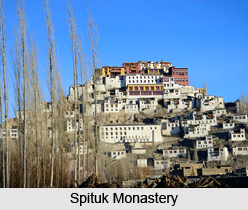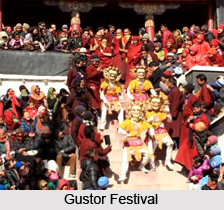 Spituk monastery, also known as Spituk Gompa or Pethup Gompa, is a Buddhist monastery. The term Spituk literally means `exemplary`. The monastery was built to help develop an exemplary religious community in Ladakh. The spituk monastery belongs to Gelugpa sect or Yellow Hat order of Tibetan Buddhism. The monastery currently provides shelter to about 100 monks.
Spituk monastery, also known as Spituk Gompa or Pethup Gompa, is a Buddhist monastery. The term Spituk literally means `exemplary`. The monastery was built to help develop an exemplary religious community in Ladakh. The spituk monastery belongs to Gelugpa sect or Yellow Hat order of Tibetan Buddhism. The monastery currently provides shelter to about 100 monks.
Location of Spituk Monastery
The monastery is located in the Leh district of Ladakh in northern India. It is 8 Km from Leh.
History of Spituk Monastery
Spituk monastery was built in the 11th century. It was founded by Od-de, the elder brother of Lha Lama Changchub Od.
At the time of Dharma Raja Gragspa Bum-Ide, the monastery was reinstated by Lama Lhawang Lodos and the stainless order of Tsonkhapa was introduced. Founded as a Red Hat institution, the monastery was taken over by the Yellow Hat sect in the 15th century.
Attractions of Spituk Monastery
The monastery is encircled with beautiful view of nature. Indus River flows behind the monastery, beyond which can be viewed the snow-capped peaks of the Himalayas. The monastery also dictates a panoramic view of the Indus Valley for miles.
 Numerous images of Lord Buddha can be seen in this monastery. There is a Dukhang or the assembly hall which displays five thankas` that are scroll painting on silk and brocade. It also houses a prized ancient collection of masks, antique arms and an admiring idol of Mahakaal.
Numerous images of Lord Buddha can be seen in this monastery. There is a Dukhang or the assembly hall which displays five thankas` that are scroll painting on silk and brocade. It also houses a prized ancient collection of masks, antique arms and an admiring idol of Mahakaal.
The monastery has a sacred idol of Amitayus that is a finger high in size. The idol was presented by Tsongkhapa to Takspa Bum-Lde. It also has a statue of the female Bodhisattva Tara.
Festival of Spituk Monastery
The most popular festival celebrated here is the Gustor festival. The festival is celebrated from 27th to 29th day in the eleventh month of the Tibetan calendar. Gustor festival marks the victory of virtue over evil.
Mask dance is an integral part of this festival. Lamas perform mask dances to defeat evil spirits. Besides prayers, music, and dance, traditional art and a cultural exhibition is also displayed by the locals. The festival ends with the symbolic termination of evil which is exhibited by the burning of an image.




